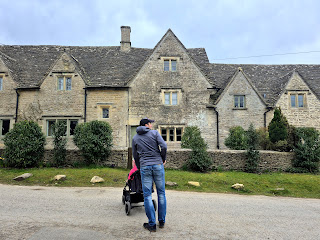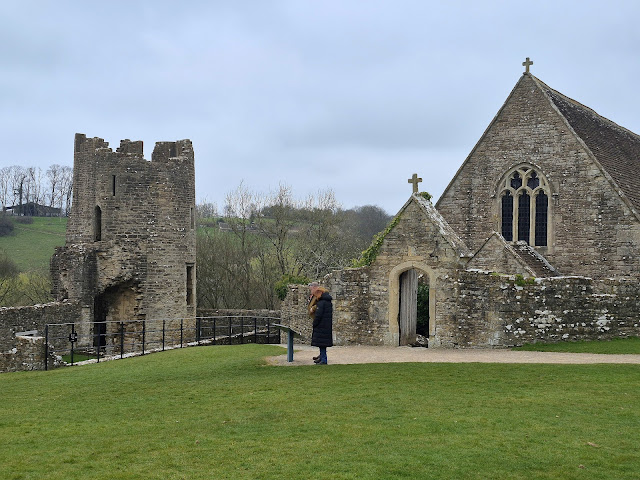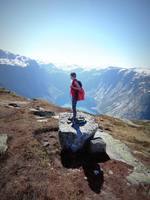Cotswolds: the most beautiful villages in England
Imagine a typical English countryside with honey-coloured brick houses, flowers in bloom and sheep grazing as far as the eye can see. No meccas far and wide, no Starbucks just cosy cafes and stylish guesthouses. Well, that's exactly what the Cotswolds is, undoubtedly one of the most beautiful areas in the whole of England.
Not surprisingly, many of the villages and specific houses and nooks and crannies have served as film locations, so you may actually "know" the Cotswolds already. You may have seen snippets of it in films such as the Bond film Don't Die Today, the TV series Downtown Manor, or the more recent (and my favourite) Slow Horses and Stardust, among many others.
Where to stay?
Romantic hotels are aplenty in the Cotswolds, but to be honest we weren't exactly looking for that. The aim was more to just lay our heads down for the night, have breakfast in the morning and move on, so I chose a total of three accommodations in the area - one on the way from Bristol in Gloucester (Robinswood Hotel), second in Oxford (Hampton by Hilton) and third pieace near Bath (The Northey Arms), so we don't have to go too far to the airport. I can only recommend all of them, I already mentioned the first two in my previous article, so that leaves The Northey Arms, which is a really nice boutique hotel with nice rooms, its own restaurant and a playground. The price came to € 138 per night with breakfast and parking. And if you'd like to stay in one of those typical villages, check out these tips:
- cheaper: The Angel at Burford or The Lamb Inn - both beautiful rooms, where you can fit in € 140 for a night with breakfast.
- more expensive: The Slaughters Manor House or The Old Stocks Inn - beautiful styles with freestanding bathtubs and similar little things

|
| Bourton-on-the-Water |
So now how do we line up the best places in order to make some sense? I'll say right now that I don't have a universal guide for this, I can only write down what order suited us. We took places 1 to 7 in exactly that order on the way to Oxford. The last three, located more in the southern part of the Cotswolds, are, on the other hand, manageable if you're heading to Bath.
I don't plan to go into too much detail in the following lines, as all the places are beautiful, so I'll try to pick out some rather practical info, and you can enjoy the photos in peace, how about that? :)
1. Bibury
We started our journey in what is supposedly the prettiest village in the Cotswolds, although that could be argued, Bibury. You can park for free right in the centre by the River Coln, but there aren't many spaces, so it's no fun in high season. The biggest local attraction is Arlington Row, an alley of interlocking brick houses, but to avoid just going back and forth from the car park, you can make a loop of it via Akward Hill and Hawkers Hill. This will then take you past The Twig bakery and cafe and out at the trout farm where you can grab your own lunch or maybe go mini golfing, see Bibury Trout Farm.
2. Bourton-on-the-Water
As a practical matter, parking on the High Street is free. As well as sightseeing, there's also a miniature village The Model Village, labyrinth Dragonfly Maze or museums of classic cars and motorbikes Motoring Museum.
3. Lower Slaughter
This is a really short stop for me just outside of Bourton. The beautiful houses, bridges over the river, the old mill and St Mary's Church are worth checking out again. Plus I was impressed with the horse riding, so if you have older kids, here's a way to get them to remember this trip :)

4. Cotswold Farm Park
5. Broadway
The town itself is as beautiful as all the others - streets with bright brick houses, small shops and cafes, in short, the perfection of the English countryside again. In the case of Broadway, however, you'll be interested in its immediate surroundings as well.
One of the biggest attractions is the stone Broadway Tower, which houses a small museum inside and, of course, a viewing platform on top. You can do a short walking tour and maybe you'll be lucky enough to see a herd of the locals - red deer. Be warned, both the tower and the park are privately owned so don't let the entrance fee surprise you - park alone £4, park + tower £14. There is a small charge for children up to 6 years old. Ticket price includes parking and you can refresh yourself in one of the two cafes. All info can be found here.
The other Broadway attraction is the 16th century country house and gardens - Snowhill Manor, protected by the National Trust. It belonged to the passionate collector Ch. P. Wade, who amassed more than 22,000 objects in his lifetime, which he left in the house, so there will definitely be something to see. Info on opening times and prices can be found on the official website here. As a final Broadway-related item, I'd like to mention The Gloucestershire Warwickshire Railway steam train, which stops here. If you're a train fan and have some extra time, be sure to check out their website for timetables, stops and fares.
6. Chipping Campden
A small commercial (chipping = from Old English cēping = market) town known for its terraced High Street dating from the 14th to 17th centuries. It used to be the main meeting point for wool merchants, and you can still see the original Market Hall and Town Hall here. In the surrounding houses you can check out the local galleries and various handicraft shops, or just hang out in one of the tea/coffee shops.
7. Stow-on-the-Wold
Another trading town, the heart of which is Market Square, which was used for selling sheep. Supposedly that's why the square is so wide, to accommodate all the vendors + their sheep, and the surrounding streets are rather short and winding to make counting sheep easier. Today, though, regular farmers' markets are still held, but in a different location, leaving the square with its mix of shops, restaurants and cafes to the tourists.
What you shouldn't miss is St Edward's Church, which houses one of the most popular photo spots in the Cotswolds - Tolkien's Door. This is because J.R.R. Tolkien studied at the nearby Oxford University and during his wanderings around the area, he came across a door flanked on either side by old yew trees. It was probably the inspiration for the entrance to the ancient dwarven kingdom of Moria.
8. Fairleigh Hungeford Castle
Today the castle is a mere ruin, the courtyard with the entrance gate, the towers, the priest's house and the chapel with the tombs of the Hungefords have been preserved. Parking here is free and you'll need to be prepared to pay £9 for a tour (£8 online in advance); children aged 5 and over are charged. You can also use a free audio guide as part of the self-guided tour.
9. Bradford-on-Avon
A small town near Bath where you can spend a few hours wandering around the historic centre and walking along the River Avon. Along the way you'll be sure to cross the local pride, the 14th century Town Bridge, and follow the footpath to the popular canals with their many boats. If you've got the kids with you, Barton Farm Country Park will definitely be your destination, where you'll find several playgrounds, picnic tables and several cafes. Here you'll also come across another Bradford must see - the medieval Tithe Barn.
10. Castle Combe
And the best at the end! My favourite was the tiny village of Castle Combe, which I've had my eye on since I saw it on Slow Horses. There's basically nothing specific to see here, no historical monuments, no shops, even the food options were very limited in the spring (read: only the hotel bar was open in the afternoon) but still...
The main street, The Street, with its tiny triangular square, is a kind of undulating beauty lined with country houses where you can just walk around and look. That's all. Of course, you can't leave Castle Combe without a photo of the houses by the Bybrook River - Water Lane.
If this information has helped you to save some time or money or both, you can "invite me for a coffee" and contribute to the running of Travel with Donuts :) account number / QR code: 1257951017/3030











































.jpg)

































Žádné komentáře: